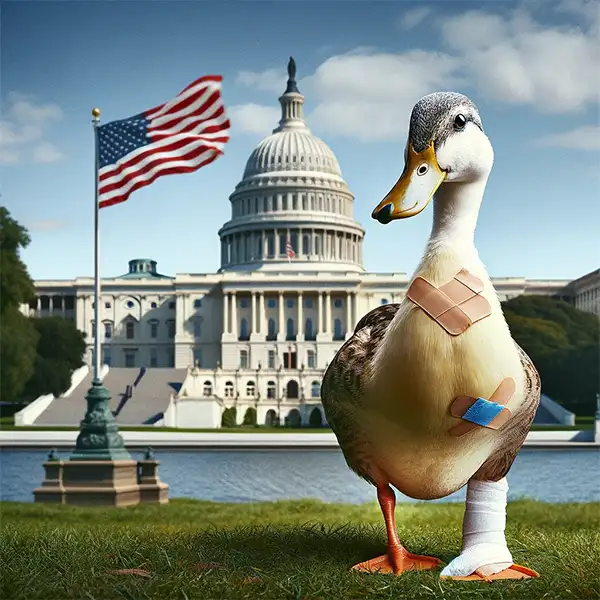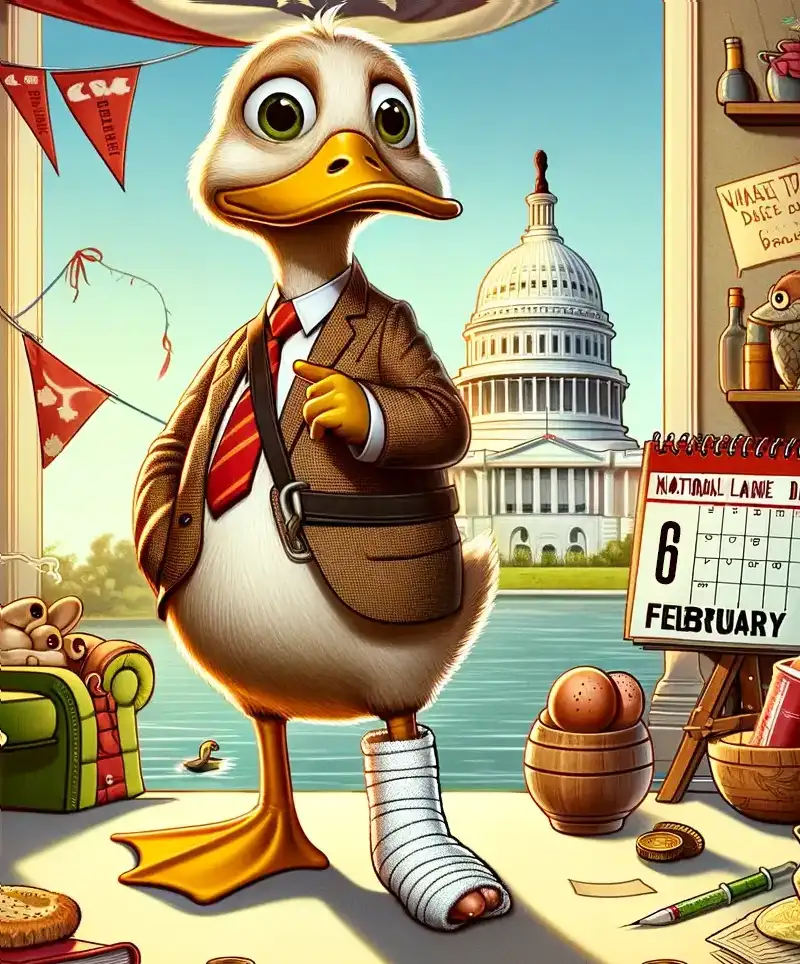Quacking Up
National Lame Duck Day, observed annually on February 6, is a whimsical blend of political satire and historical intrigue, making it a surprisingly captivating day in the annual calendar. It’s a day when the term “lame duck” - typically reserved for outgoing politicians who are in the twilight of their tenure - is celebrated with a mixture of humor and contemplation. This is the day to ponder the oddities of political transitions, the peculiarities of power, and yes, to chuckle at the somewhat awkward position of those who are still in office after their successor has been elected but before the new term begins. From its origins in 18th-century stock exchange slang to its current place in modern political discourse, National Lame Duck Day is as much about history as it is about the hilarity inherent in human endeavors of governance.
Why "Lame Duck"?
The term "lame duck" originally comes from the London Stock Exchange in the 18th century, used to describe a broker who defaulted on his debts. The image of a duck limping along paints a vivid picture of ineffectiveness, which was later adopted in politics. In the U.S., the 20th Amendment, nicknamed the "Lame Duck Amendment," shortened the time outgoing politicians remained in office, but it didn't eliminate the phenomenon entirely.
On National Lame Duck Day, we don't just acknowledge these political figures; we revel in the often-humorous limbo state of their careers. Imagine the scene: a politician, defeated or term-limited, wandering the halls of power like a ghost of governance past, still attending meetings but with significantly less clout. It's a bit like being the only senior at a high school party post-graduation - still there, but definitely out of the loop.
The Duck Pond of Politics
 The concept of the "lame duck" period in politics is akin to navigating a unique pond, where the usual rules and dynamics of power are subtly, and sometimes not-so-subtly, altered. This period, which National Lame Duck Day brings into focus, is a fascinating study in political behavior, strategy, and the shifting tides of power.
The concept of the "lame duck" period in politics is akin to navigating a unique pond, where the usual rules and dynamics of power are subtly, and sometimes not-so-subtly, altered. This period, which National Lame Duck Day brings into focus, is a fascinating study in political behavior, strategy, and the shifting tides of power.
The Art of the Exit: During their final days in office, some lame-duck officials transform into political artists, painting their last strokes on the canvas of governance. This can manifest in a variety of ways. For some, it's a flurry of legislative activity, an attempt to leave a lasting impact or to secure a legacy. These last-minute laws and decisions can range from deeply significant to downright puzzling, but they all share a common thread – the urgency of a closing window.
The Freedoms of a Duck: One of the most intriguing aspects of the lame-duck period is the newfound freedom it can bring. Freed from the pressures of reelection campaigns, some politicians become more candid, sometimes veering into uncharted waters of honesty or controversy. This can lead to unexpected alliances, surprising policy shifts, or blunt admissions that would have been unthinkable during their time in the electoral spotlight.
The Target on Their Backs: Conversely, lame ducks often find themselves easy targets for criticism and opposition. With their influence waning and their time running out, they can become scapegoats for unresolved issues or unpopular decisions. This period can be a delicate balancing act – wielding power while being acutely aware of its impending end.
The Role of the Successor: The dynamic between the outgoing official and their successor also adds an interesting layer to the lame-duck period. Sometimes, this relationship is cooperative, characterized by a smooth and cordial transition. Other times, it's tense and fraught with political maneuvering, as the incoming figure seeks to assert their upcoming authority while the current one tries to cement their agenda.
The Impact on Governance: The lame-duck period also raises questions about the effectiveness of governance. How do these final acts and decisions get perceived and implemented? Is there a loss of momentum in government operations, or does it spur a burst of activity? The answers vary, but they all reflect the complexities of political power and transition.
Reflections in the Pond: National Lame Duck Day, therefore, serves as a mirror reflecting these varied aspects of political transitions. It's a day that encourages us to look beyond the simple label of "lame duck" and delve into the nuanced and often turbulent waters of political change. Whether it's seen as a time of unrestrained opportunity or vulnerable target-hood, the lame-duck period is undoubtedly a significant phase in the lifecycle of political careers.
The pond of politics during the lame-duck period is anything but still. It's a time of action, reflection, and, sometimes, unexpected turns. As we observe National Lame Duck Day, we're invited to ponder these dynamics, understanding the complexities and sometimes the humor that comes with this unique political phenomenon.
Celebrating the Quackery
How does one celebrate National Lame Duck Day? Perhaps by sending a humorous, yet respectful, card to your favorite outgoing politician or hosting a "Lame Duck" party where guests dress as their favorite political figures in their less glorious moments. Trivia games about historical political blunders or a "duck and cover" hide-and-seek game, symbolizing the avoidance tactics of politicians, can add to the fun.
While it's easy to poke fun, National Lame Duck Day also invites us to ponder the serious side of political transitions. It's a time to consider how power shifts and how policies can change rapidly, impacting lives in significant ways. It's a reminder of the importance of political engagement and the need for smooth transitions in governance.
National Lame Duck Day might not be marked by parades or fireworks, but it holds a special place in the political and cultural landscape. It's a day for humor, reflection, and, of course, a little bit of sympathy for the ducks still waddling through the halls of power. So here's to the lame ducks - may their final quacks echo with dignity and a touch of whimsy!
Please Share our Content






 The concept of the "lame duck" period in politics is akin to navigating a unique pond, where the usual rules and dynamics of power are subtly, and sometimes not-so-subtly, altered. This period, which National Lame Duck Day brings into focus, is a fascinating study in political behavior, strategy, and the shifting tides of power.
The concept of the "lame duck" period in politics is akin to navigating a unique pond, where the usual rules and dynamics of power are subtly, and sometimes not-so-subtly, altered. This period, which National Lame Duck Day brings into focus, is a fascinating study in political behavior, strategy, and the shifting tides of power.








 "Sláinte!" is a traditional Irish expression used as a toast, equivalent to "Cheers!" in English.
"Sláinte!" is a traditional Irish expression used as a toast, equivalent to "Cheers!" in English.